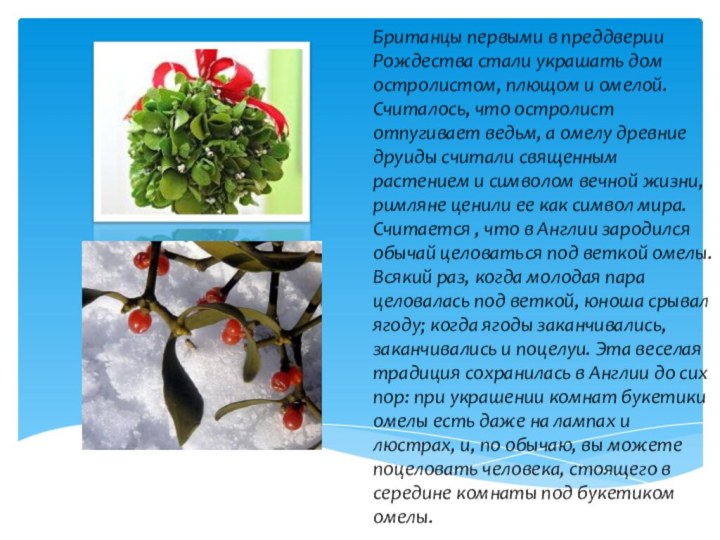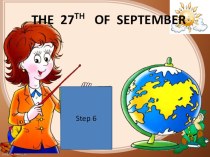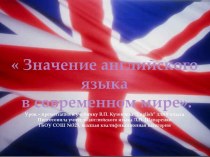- Главная
- Разное
- Бизнес и предпринимательство
- Образование
- Развлечения
- Государство
- Спорт
- Графика
- Культурология
- Еда и кулинария
- Лингвистика
- Религиоведение
- Черчение
- Физкультура
- ИЗО
- Психология
- Социология
- Английский язык
- Астрономия
- Алгебра
- Биология
- География
- Геометрия
- Детские презентации
- Информатика
- История
- Литература
- Маркетинг
- Математика
- Медицина
- Менеджмент
- Музыка
- МХК
- Немецкий язык
- ОБЖ
- Обществознание
- Окружающий мир
- Педагогика
- Русский язык
- Технология
- Физика
- Философия
- Химия
- Шаблоны, картинки для презентаций
- Экология
- Экономика
- Юриспруденция
Что такое findslide.org?
FindSlide.org - это сайт презентаций, докладов, шаблонов в формате PowerPoint.
Обратная связь
Email: Нажмите что бы посмотреть
Презентация на тему по английскому языку на тему День Святого Валентина( 5 класс)
Содержание
- 2. Christmas - a holiday, which in many
- 3. Рождество – это праздник, который во многих
- 4. The British first in the run up
- 5. Британцы первыми в преддверии Рождества стали украшать
- 6. One of the ancient British traditions -
- 7. From Victorian England linked the custom to
- 8. С Викторианской Англией связан обычай складывать подарки
- 9. For centuries, all the inhabitants of the
- 10. На протяжении многих веков у всех жителей
- 11. The beautiful tradition of decorating the house
- 12. Прекрасная традиция украшать дом к Рождеству вечнозелеными
- 13. Four weeks before Christmas religious people bring
- 14. За четыре недели до Рождества верующие люди
- 15. Christmas in England is celebrated on December
- 16. On this day, almost every house sounds
- 17. Скачать презентацию
- 18. Похожие презентации
Christmas - a holiday, which in many countries has created a large number of symbols and traditions. These include even his date. Initially, the Eastern Christian church established the celebration of Christmas on January 6. However,

















Слайд 3
Рождество – это праздник, который во многих странах
породил большое количество символов и традиций. К ним относится
даже его дата. Первоначально восточно-христианские церкви установили празднование Рождества на шестое января. Однако Римская церковь намеренно перенесла его на двадцать пятое декабря – день языческого праздника непобедимого солнца. И новая дата стала символизировать победу христианства над язычеством. Шестое же января по западной традиции – это день Богоявления или Крещения, часто называемый англичанами Двенадцатой ночью.Слайд 4 The British first in the run up to
Christmas began to decorate the house with holly, ivy
and mistletoe. It was believed that witches scares holly and mistletoe ancient Druids considered a sacred plant and a symbol of eternal life, the Romans appreciated it as a symbol of peace. It is believed that the custom originated in England, kissing under the mistletoe branch. Whenever a young couple kissing under a branch, the boy plucked a berry; When berries are ended, and ended with kisses. This fun tradition has survived in England until now: the decoration of the rooms bunches of mistletoe is even on lamps and chandeliers, and, as usual, you can kiss a man standing in the middle of the room under a bunch of mistletoe.Слайд 5 Британцы первыми в преддверии Рождества стали украшать дом
остролистом, плющом и омелой. Считалось, что остролист отпугивает ведьм,
а омелу древние друиды считали священным растением и символом вечной жизни, римляне ценили ее как символ мира. Считается , что в Англии зародился обычай целоваться под веткой омелы. Всякий раз, когда молодая пара целовалась под веткой, юноша срывал ягоду; когда ягоды заканчивались, заканчивались и поцелуи. Эта веселая традиция сохранилась в Англии до сих пор: при украшении комнат букетики омелы есть даже на лампах и люстрах, и, по обычаю, вы можете поцеловать человека, стоящего в середине комнаты под букетиком омелы.Слайд 6 One of the ancient British traditions - Christmas
log. It is believed that more ancient Vikings brought
this rite in England. At Christmas they cut down a huge tree, and all year it lay - dried up. And only at the next Christmas he was brought into the house, and it was burning in the hearth for a long time. If the faded, not burned to ashes, the owners were expecting trouble.Одна из древних британских традиций - рождественское полено. Считается, что ещё древние викинги принесли этот обряд в Англию. На Рождество они спиливали огромное дерево, и весь год оно лежало - сохло. И только на следующее Рождество его приносили в дом, и оно горело в очаге долго-долго. Если же гасло, не прогорев до пепла, хозяева ожидали беды.
Слайд 7 From Victorian England linked the custom to put
gifts in the Christmas stocking. While telling a story
that "Father Christmas" traveled through the air and enter the house through the chimney. Going into one of the houses, he dropped some gold coins in a sock, which hung over the fireplace to dry. Since then, on Christmas Eve at the fireplace began to hang out "socks and stockings in the hope that there is a fall." And now, on Christmas Eve children hang on the fireplace or the bed Christmas Stocking to Santa filled it with gifts.Слайд 8 С Викторианской Англией связан обычай складывать подарки в
Рождественский носок. В то время рассказывали сказку, что «Рождественский
дед» путешествовал по воздуху и проникал в дома через дымовую трубу. Спускаясь в один из домов, он обронил несколько золотых монет в носок, который повесили сушиться над очагом. С тех пор в Рождественский сочельник на камин стали вывешивать «носки и чулки в надежде, что туда что-нибудь упадет». И сейчас в канун Рождества дети вешают на камин или край кровати рождественский чулок, чтобы Санта Клаус наполнил его подарками.Слайд 9 For centuries, all the inhabitants of the British
Isles common dish for Christmas was a special porridge
Plum-porridzh (plum-porridge), boiled in broth, it also added bread crumbs, raisins, almonds, prunes and honey and bring to the table is very hot. Pudding cooked in large copper kettles in the weeks before Christmas the whole family. In the preparation of each member of the family to make a wish. The pudding was placed 4 items: coins, a thimble, buttons and rings. Later, when the pudding is eaten every item found in the pudding has its value. The coin means wealth in the new year, buttons - bachelor life, thimble meant for unmarried girls life ring - marriage (marriage).Слайд 10 На протяжении многих веков у всех жителей Британских
островов распространенным кушаньем на Рождество была особая овсяная каша
плум-порридж (plum-porridge), сваренная на мясном бульоне, в нее добавляли также хлебные крошки, изюм, миндаль, чернослив и мед и подавали на стол очень горячей. Пудинг готовили в больших медных котлах за несколько недель до Рождества всем семейством. При приготовлении каждый член семейства загадывал желание. В пудинг клали 4 предмета: монету, наперсток, пуговицу и кольцо. Позже, когда пудинг ели, каждый найденный в пудинге предмет имел свое значение. Монета означала богатство в новом году, пуговица - холостяцкую жизнь, наперсток для девушки означала незамужнюю жизнь, кольцо - замужество (женитьбу).Слайд 11 The beautiful tradition of decorating the house for
Christmas with evergreen boughs of ivy, holly, and so
on. E. Preserved to this day, as the custom to hang on the front door mistletoe sprigs. According to ancient custom once a year (just before Christmas), men are entitled to kiss any girl who for any reason will stop at posted on the door of a sprig of mistletoe.Слайд 12 Прекрасная традиция украшать дом к Рождеству вечнозелеными веточками
плюща, остролиста и т. д. сохранилась и по сей
день, как и обычай, подвешивать на входной двери веточки омелы белой. По старинному обычаю один раз в году (как раз в канун Рождества), мужчины получают право поцеловать любую девушку, которая по любой причине остановится под вывешенной на двери веточкой омелы.Слайд 13 Four weeks before Christmas religious people bring home
a special wreath - "Advent Wreath". Unlike simple wall
Christmas wreath, they are placed on this table and is fixed on it four candles are lit every Sunday, but not simultaneously, but in succession - first one, then two and so on.Слайд 14 За четыре недели до Рождества верующие люди приносят
домой особый венок – "Advent Wreath". В отличие от
простых настенных рождественских венков, этот кладут на стол и закрепляют на нём четыре свечи, которые зажигают каждое воскресенье, но не одновременно, а по очереди – сначала одну, потом две и так далее.Слайд 15 Christmas in England is celebrated on December 25.
On this day, the majority of families are sent
to the church, and after that going to the banquet table. Also on this day, at 3 o'clock on all radio and television stations betrayed festive appeal of the Queen.Рождество в Англии празднуется 25 декабря. В этот день большинство семей направляются в церковь, а после нее собираются за праздничным столом. Также в этот день в 3 часа по всем радио и телеканалам передается праздничное обращение королевы.





























